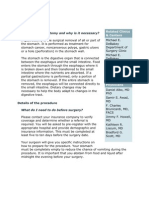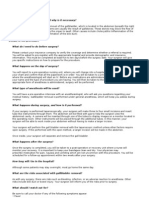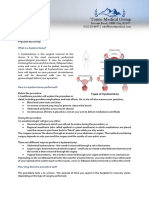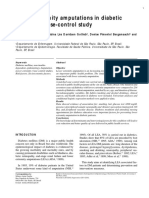Emergency Laparotomy: Patient Information Factsheet
Emergency Laparotomy: Patient Information Factsheet
Uploaded by
Muhammad RizqiCopyright:
Available Formats
Emergency Laparotomy: Patient Information Factsheet
Emergency Laparotomy: Patient Information Factsheet
Uploaded by
Muhammad RizqiOriginal Title
Copyright
Available Formats
Share this document
Did you find this document useful?
Is this content inappropriate?
Copyright:
Available Formats
Emergency Laparotomy: Patient Information Factsheet
Emergency Laparotomy: Patient Information Factsheet
Uploaded by
Muhammad RizqiCopyright:
Available Formats
Patient information factsheet
Emergency laparotomy
This leaflet explains what to expect if you are having an emergency operation for a sudden or
serious medical problem in the abdomen (stomach area).
What is an emergency laparotomy?
An emergency laparotomy is a surgical operation that is used for people with severe abdominal pain to find
the cause of the problem and in many cases to treat it. You will have a general anaesthetic and the surgeon
will make an incision (cut) to open the abdomen (stomach area). Often the damaged part of an organ is
removed and the abdomen washed out to limit any infection.
An emergency laparotomy might be carried out for several reasons including bowel obstruction (blockage),
bowel perforation (burst) and bleeding in the abdominal cavity (internal bleeding). These are conditions
which if left untreated could be life-threatening. An emergency laparotomy is used either to save life or to
limit illness, and in many cases it might be the only option available in order for the patient to get better.
What happens before surgery?
A member of the surgical team will assess you fully, ask you questions about your symptoms and
examine you. You will have some blood tests carried out and a CT scan is normally required to help make a
diagnosis and plan treatment.
Once a decision has been made that an operation is needed, a senior surgeon will visit you to explain the
procedure and ask for your written consent. An anaesthetist and sometimes a member of the intensive care
team will also assess you before your surgery. This team of doctors will be able to tell you about the risks of
the operation compared to the risks of your illness without surgery.
If you are too unwell to consider the risks and give your consent, then the surgeon is legally able to act in
your best interest and proceed with the operation without having written consent. If this is the case, it will
be discussed with your family or carers and two doctors will sign the consent form together. If you have a
written advance directive (living will), then that will be used to inform the doctors about your wishes.
Timing of surgery
If your condition is very serious, the laparotomy will take place soon after the decision has been made that
it is needed, sometimes within two hours. If your condition is less serious, the operation may be delayed to
allow further tests and treatment to take place.
The role of your anaesthetist
Your anaesthetist will discuss the general anaesthetic with you and any particular risks relating to your
medical condition. They will also decide whether intensive care is needed to help you recover.
www.uhs.nhs.uk
Patient information factsheet
Pain relief
Your anaesthetist will discuss with you how your pain will be managed after the surgery. You will be given
regular pain relief medicines which may include one of the following:
Wound catheters very fine soft plastic tubes which are placed under the skin on each side of the
wound by the surgeon during the operation. They are connected to a pump that continuously delivers
local anaesthetic which helps relieve the pain from the wound. They can stay in for several days after
your operation.
An epidural a fine plastic tube that your anaesthetist will place between the bones of your back.
This is usually done just before you go to sleep. Local anaesthetic is given through this tube during
the operation and for a few days afterwards. Your chest, abdomen and legs may feel numb whilst the
epidural is being used, and your legs may not feel as strong as normal. This is to be expected while the
epidural is working and will return to normal when the local anaesthetic wears off.
Surgical drains and tubes
During the surgery it is common to have a number of tubes and drains inserted:
The surgeon or a nurse will insert a catheter (soft plastic tube) into your bladder to drain away and
measure the urine that you produce.
The surgeon may place some drains in your abdomen to prevent infected fluid from accumulating during
the recovery period.
You may have a naso-gastric tube (soft plastic tube that is placed in the nose and goes down as far
as the stomach). This helps drain fluid from your stomach and stops you being sick. Sometimes this is
inserted on the ward before surgery. This tube may also be used to help with feeding after surgery.
There will be a cannula in a vein in your arm to allow intravenous fluids and medicines to be given.
Occasionally, your anaesthetist may also place a cannula in a vein in the side of your neck for the
same purpose.
These tubes and drains will be reviewed daily after your operation. Most can be removed within
48 to 72 hours.
A stoma
Some people need a stoma after an emergency laparotomy. The team looking after you will tell you if this is
a possibility for you.
A stoma is formed when one of the ends of the bowel is brought out through a hole in your abdomen
and stitched to the surface of your abdomen. This arrangement diverts faeces from your bowel directly into
a disposable bag. A stoma is normally a temporary arrangement that allows the bowel time to heal.
This healing can take three to six months, after which time you would be offered another operation to
rejoin your bowel and have the stoma removed. Occasionally a permanent stoma is required after this kind
of operation.
If a stoma is formed during your surgery you will meet the specialist stoma nurses who will teach you how
to care for it.
www.uhs.nhs.uk
Patient information factsheet
What happens after surgery?
Depending on your condition before and during the surgery, you may need to spend some time in the high
dependency unit (HDU) or intensive care unit (ICU) afterwards. The team looking after you will decide if this
is necessary.
If you have developed significant lung or heart problems the anaesthetist and intensive care team may
decide that you would benefit from a period when a ventilator is used to support your breathing. If this
happens you would remain anaesthetised on the ICU until you are well enough to be allowed to wake up
and breathe for yourself.
Further surgery may be needed in the days following your initial operation. There are many reasons for this.
Often, it is simply to check that the bowel is beginning to heal and to assess and treat any areas of infection.
Complications
This is emergency surgery and complications are common. These can include straightforward complications
such as urine and wound infections which can usually be treated with good results. Major, potentially
life-threatening complications such as failure of vital organs can also happen. Treatment of organ failure in
the ICU is often successful in allowing recovery.
With this in mind, the surgical team will always consider other treatment options when deciding whether
or not an emergency laparotomy operation is right for you. They will give you advice based on their
experience and on the information they have from the investigations they have done. Your wishes and your
opinion are extremely important in the decision making process.
Recovery from emergency laparotomy
There are several important aspects to your recovery after emergency surgery, which will be addressed:
Physiotherapy it is very important after major surgery that you take deep breaths and cough
effectively. This helps to prevent chest infections. Physiotherapists will visit you during your recovery to
give you advice and breathing exercises to help with this.
Nutrition good nutrition is an essential part of your recovery. It often takes several days for your
bowels to work normally after an emergency laparotomy. During this time you may feel bloated and
have very little appetite. You may feel sick and sometimes be sick. Your surgeon will advise you on how
much fluid and food you can have in these early days. They may prescribe anti-sickness medicines if
nausea is a particular problem. If you are unable to start eating after two to three days, your surgeon
may give you liquid nutrition through a naso-gastric tube or through a cannula into a vein.
Pain relief the surgical team will strive to ensure that you are comfortable at every stage during
your recovery. If you have needed a local anaesthetic infusion (either as an epidural or directly into your
wound) this will continue for about three days after the operation. You may be given morphine as well
during this time. It is important that you are given sufficient pain relief to enable you to cough effectively.
Please ask the nurses if you need more pain relief. After about three days you should need less morphine
and more simple pain relief medicines such as paracetamol.
Exercise this may seem a long way off, but it is important to gradually build up your fitness after your
operation, as you feel able. The nurses and physiotherapists will help you with this. Getting back on your
feet reduces the risk of complications such as deep vein thrombosis (blood clots) and chest infections.
You will have daily injections while you are in hospital to prevent blood clots.
www.uhs.nhs.uk
Patient information factsheet
How long does it take to recover?
Recovery depends on the surgery, severity of the illness, your age and any other health conditions you may
have. We aim for you to be eating within three to four days and home within seven to fourteen days.
It can take around three months to return to normal activities but as long as a year to feel fully recovered.
If you have any questions or would like more information after reading this factsheet please ask the medical
team or nurse practitioners looking after you.
If you need a translation of this document, an interpreter or a version
in large print, Braille or on audio tape, please call 023 8120 4688.
2015 University Hospital Southampton NHS Foundation Trust. All rights reserved. Not to be reproduced in whole or in part without the permission of the copyright holder.
Version 1. Published February 2015. Due for review February 2018. 2014-789
www.uhs.nhs.uk
You might also like
- PADIS Guidelines Teaching Slides SedationDocument27 pagesPADIS Guidelines Teaching Slides SedationMohamat MutajirNo ratings yet
- Appendectomy OverviewDocument4 pagesAppendectomy OverviewEdna VilchezNo ratings yet
- Laparoscopic Heller MyotomyDocument7 pagesLaparoscopic Heller MyotomylazelifestyleNo ratings yet
- Nephrectomy Nov16Document7 pagesNephrectomy Nov16Devanshi JoshiNo ratings yet
- Total Laparoscopic Hysterectomy (TLH) : Patient Information Patient InformationDocument7 pagesTotal Laparoscopic Hysterectomy (TLH) : Patient Information Patient InformationMUKUL SAXENANo ratings yet
- CF417 Open CholecystecomyDocument10 pagesCF417 Open CholecystecomyTania Louise Pioquinto AbuanNo ratings yet
- Abdominal HysterectomyDocument12 pagesAbdominal Hysterectomytaufique1123No ratings yet
- Patient Information and Consent To HaemorrhoidectomyDocument13 pagesPatient Information and Consent To Haemorrhoidectomytamara annadiaNo ratings yet
- Total Gastrectomy ConsentDocument18 pagesTotal Gastrectomy ConsentTanyaNganNo ratings yet
- 5960 1 Hartmanns ProcedureDocument8 pages5960 1 Hartmanns ProcedureZakiNo ratings yet
- PD 7229 Gastrectomy SurgeryDocument12 pagesPD 7229 Gastrectomy SurgerydanangpurmdNo ratings yet
- Or Write Up 52611Document14 pagesOr Write Up 52611babydumplingsNo ratings yet
- Vaginal Hysterectomy and Vaginal Repair: Women's ServiceDocument16 pagesVaginal Hysterectomy and Vaginal Repair: Women's Serviceintan yulia safarinaNo ratings yet
- Private Laparoscopy Information MR Philip Kaloo. The Gynaecology GroupDocument4 pagesPrivate Laparoscopy Information MR Philip Kaloo. The Gynaecology Groupthe gynaecology groupNo ratings yet
- Umbilical Hernia RepairDocument11 pagesUmbilical Hernia RepairMantu DasNo ratings yet
- Pectus Carinatum Leaflet PIAG 212Document9 pagesPectus Carinatum Leaflet PIAG 212MellNo ratings yet
- What Is A Total Abdominal Hysterectomy?Document8 pagesWhat Is A Total Abdominal Hysterectomy?Iuthisam HassanNo ratings yet
- 25 Myomectomy Consent FormDocument4 pages25 Myomectomy Consent FormDrscottmccallNo ratings yet
- What Is Laparoscopy?Document8 pagesWhat Is Laparoscopy?Kamran AfzalNo ratings yet
- Hartmann's Procedure: Patient Information - General SurgeryDocument7 pagesHartmann's Procedure: Patient Information - General SurgeryputriNo ratings yet
- Rec To Vaginal Fistula RepairDocument7 pagesRec To Vaginal Fistula Repairnaftalina7No ratings yet
- 27 Ovarian Cystectomy Consent FormDocument3 pages27 Ovarian Cystectomy Consent FormsekyNo ratings yet
- GastrectomyDocument13 pagesGastrectomyrhopmaeNo ratings yet
- When You Need An Operation... About Hernia Repair: American College of SurgeonsDocument7 pagesWhen You Need An Operation... About Hernia Repair: American College of Surgeonsfauziahputri29No ratings yet
- Laparoscopic Removal of The Adrenal GlandDocument8 pagesLaparoscopic Removal of The Adrenal GlandTarek AliNo ratings yet
- CholecystectomyDocument8 pagesCholecystectomyApril_Ivy_Raga_3835No ratings yet
- Abdominal HysterectomyDocument7 pagesAbdominal HysterectomyIcicNo ratings yet
- Cell Biology MicroDocument7 pagesCell Biology MicroKim Dela CruzNo ratings yet
- AppendectomyDocument7 pagesAppendectomyLeis FatwaNo ratings yet
- NIH Clinical Center Patient Education Materials Post-Op Instructions: Taking Care of Yourself After SurgeryDocument3 pagesNIH Clinical Center Patient Education Materials Post-Op Instructions: Taking Care of Yourself After SurgeryDevasyaNo ratings yet
- Patient Leaflet - HysterectomyDocument3 pagesPatient Leaflet - HysterectomyChristian CayabyabNo ratings yet
- 05 EpiduralAnaes2023webDocument5 pages05 EpiduralAnaes2023webcinder.roseNo ratings yet
- Script For MastectomyDocument7 pagesScript For MastectomyKENJ ABELLANo ratings yet
- Bed Side Teaching Whipple'S Procedure: Submitted To-Sarita Nadiya Madam Submitted By-Ms - ManishaDocument8 pagesBed Side Teaching Whipple'S Procedure: Submitted To-Sarita Nadiya Madam Submitted By-Ms - ManishaManisha Shakya100% (1)
- Abdomino-Perineal Resection/Excision of The Rectum: Surgical DirectorateDocument5 pagesAbdomino-Perineal Resection/Excision of The Rectum: Surgical DirectorateYa Mei LiNo ratings yet
- Colonic Stenting - Final Version - PBCNDocument8 pagesColonic Stenting - Final Version - PBCNVincent Laurence H SNo ratings yet
- Laparoscopic CholecystectomyDocument10 pagesLaparoscopic CholecystectomyCharm TanyaNo ratings yet
- Total Abdominal Hysterectomy & Bilateral Salpingectomy For Benign ConditionsDocument10 pagesTotal Abdominal Hysterectomy & Bilateral Salpingectomy For Benign Conditionsnistal.champagneroseNo ratings yet
- Reversal of IleostomyDocument7 pagesReversal of IleostomyGTL StickersNo ratings yet
- Care of Preoperative Patients 1 3 .Docx-1Document4 pagesCare of Preoperative Patients 1 3 .Docx-1mark OrpillaNo ratings yet
- Having A Portcath InsertionDocument5 pagesHaving A Portcath InsertionEvaNo ratings yet
- Pectus Excavatum RepairDocument5 pagesPectus Excavatum Repairtes_syNo ratings yet
- Hernia Overview of Treatment OptionsDocument5 pagesHernia Overview of Treatment OptionsKhristine Ruth De GraciaNo ratings yet
- Evacuation of Retained Products of Conception ERPC GHPI0131!08!16Document4 pagesEvacuation of Retained Products of Conception ERPC GHPI0131!08!16Shrikant KrNo ratings yet
- Dilation and Curettage - Health TeachingDocument4 pagesDilation and Curettage - Health TeachingGol D. RogerNo ratings yet
- PD 6660 Orchiectomy SurgeryDocument4 pagesPD 6660 Orchiectomy SurgeryIndra WibawaNo ratings yet
- Surgical Management: Epidural AnesthesiaDocument4 pagesSurgical Management: Epidural AnesthesiabobtagubaNo ratings yet
- AppendectomyDocument8 pagesAppendectomydrmolinammNo ratings yet
- Bullectomy and PleurodesisDocument7 pagesBullectomy and PleurodesisriangwonNo ratings yet
- A Disease Study On: AppendectomyDocument8 pagesA Disease Study On: Appendectomybryan leguiabNo ratings yet
- TahbsoDocument42 pagesTahbsoMarlon RoyoNo ratings yet
- Total Proctocolectomy With IleostomyDocument5 pagesTotal Proctocolectomy With Ileostomyrachelmores12No ratings yet
- Pi Percutaneous Transhepatic Cholangiogram Biliary DrainageDocument8 pagesPi Percutaneous Transhepatic Cholangiogram Biliary Drainagesheryl maeNo ratings yet
- CholecystectomyDocument5 pagesCholecystectomydkbjNo ratings yet
- Gastroscopy Stent PrintDocument20 pagesGastroscopy Stent PrintYirgalem Mitiku GebreNo ratings yet
- Treating A Bartholins Cyst or Abscess Patient InformationDocument6 pagesTreating A Bartholins Cyst or Abscess Patient InformationRezaFArthaNo ratings yet
- P Max Ill EctomyDocument12 pagesP Max Ill Ectomyurwaafghan48No ratings yet
- HerniaDocument13 pagesHerniabugoy_bugoyNo ratings yet
- Hysterectomy, (Removal of Uterus) A Simple Guide To The Condition, Diagnosis, Treatment And Related ConditionsFrom EverandHysterectomy, (Removal of Uterus) A Simple Guide To The Condition, Diagnosis, Treatment And Related ConditionsRating: 5 out of 5 stars5/5 (1)
- Angioplasty, (Stent Dilatation) A Simple Guide To The Condition, Diagnosis, Treatment And Related ConditionsFrom EverandAngioplasty, (Stent Dilatation) A Simple Guide To The Condition, Diagnosis, Treatment And Related ConditionsRating: 5 out of 5 stars5/5 (1)
- Stop Yourself from Being Butchered: How Doctors and Surgeons Are Promoting Unnecessary Operations to Their PatientsFrom EverandStop Yourself from Being Butchered: How Doctors and Surgeons Are Promoting Unnecessary Operations to Their PatientsNo ratings yet
- Alis KlampDocument5 pagesAlis KlampMuhammad RizqiNo ratings yet
- Maxillofacial Trauma With Head Injuries at A Tertiary Care Hospital in Chitwan, Nepal: Clinical, Medico-Legal, and Critical Care..Document9 pagesMaxillofacial Trauma With Head Injuries at A Tertiary Care Hospital in Chitwan, Nepal: Clinical, Medico-Legal, and Critical Care..Muhammad RizqiNo ratings yet
- 13 Samira AjmalDocument6 pages13 Samira AjmalMuhammad RizqiNo ratings yet
- Analysis and Results of Prolonged Resuscitation in Cardiac Arrest Patients Rescued by Extracorporeal Membrane OxygenationDocument7 pagesAnalysis and Results of Prolonged Resuscitation in Cardiac Arrest Patients Rescued by Extracorporeal Membrane OxygenationMuhammad RizqiNo ratings yet
- High Lactate Levels Are Predictors of Major Complications After Cardiac SurgeryDocument6 pagesHigh Lactate Levels Are Predictors of Major Complications After Cardiac SurgeryMuhammad RizqiNo ratings yet
- Outcome With High Blood Lactate Levels During Cardiopulmonary Bypass in Adult Cardiac OperationDocument5 pagesOutcome With High Blood Lactate Levels During Cardiopulmonary Bypass in Adult Cardiac OperationMuhammad RizqiNo ratings yet
- AnnCardAnaesth8139-5381822 012941Document6 pagesAnnCardAnaesth8139-5381822 012941Muhammad RizqiNo ratings yet
- Hyperglycemia During: CardiopulmonaryDocument3 pagesHyperglycemia During: CardiopulmonaryMuhammad RizqiNo ratings yet
- Hyperglycemia As An Effect of Cardiopulmonary Bypass: Intra-Operative Glucose ManagementDocument6 pagesHyperglycemia As An Effect of Cardiopulmonary Bypass: Intra-Operative Glucose ManagementMuhammad RizqiNo ratings yet
- Pada Penelitian Yang Dilakukan Oleh Anjani DiDocument3 pagesPada Penelitian Yang Dilakukan Oleh Anjani DiMuhammad RizqiNo ratings yet
- Low Extremity AmputationDocument5 pagesLow Extremity AmputationMuhammad RizqiNo ratings yet
- PDF Lecture 9 Benign Soft Tissue TumorsDocument131 pagesPDF Lecture 9 Benign Soft Tissue TumorsMuhammad Rizqi100% (1)
- Barriers To Cancer Pain Management Among Nurses in Kenya - A  Focused EthnographyDocument7 pagesBarriers To Cancer Pain Management Among Nurses in Kenya - A  Focused EthnographyBIETRIS WARISYUNo ratings yet
- Content I. Definition of Staffing IV. Staffing NeedsDocument5 pagesContent I. Definition of Staffing IV. Staffing NeedsTeal Otter100% (1)
- In Health PersonaDocument4 pagesIn Health PersonaAckie LoyolaNo ratings yet
- IC 1 Minimum Standards For Intensive Care UnitsDocument15 pagesIC 1 Minimum Standards For Intensive Care UnitsRositaadlNo ratings yet
- Hospital Management Administration Project TitlesDocument1 pageHospital Management Administration Project Titlesgvani333389% (9)
- Noise Reduction in Hospital With Help of Sound Absorbing MaterialsDocument7 pagesNoise Reduction in Hospital With Help of Sound Absorbing MaterialsInternational Journal of Innovative Science and Research TechnologyNo ratings yet
- Colorado Department of Public Health and Environment: November 14 Public-Health Order UpdateDocument9 pagesColorado Department of Public Health and Environment: November 14 Public-Health Order UpdateMichael_Roberts2019No ratings yet
- Guidelines On Critical Care Hospital Block-PM-ABHIM - 2022 - 03-11-2022Document52 pagesGuidelines On Critical Care Hospital Block-PM-ABHIM - 2022 - 03-11-2022rimekaNo ratings yet
- ST Stephen Rates PDFDocument36 pagesST Stephen Rates PDFPrabhanshu TripathiNo ratings yet
- IE Visualisation Platform Brochure 496951001 V01 1113Document7 pagesIE Visualisation Platform Brochure 496951001 V01 1113Eugenio Daniel Martinez HurtadoNo ratings yet
- Developing Emergency Room Key Performance Indicators: What To Measure and Why Should We Measure It?Document5 pagesDeveloping Emergency Room Key Performance Indicators: What To Measure and Why Should We Measure It?Nehal KhalafNo ratings yet
- An Interventional Skin CareDocument11 pagesAn Interventional Skin CareTatiana SiregarNo ratings yet
- Checklist For Monitoring District Hospital: EmailDocument16 pagesChecklist For Monitoring District Hospital: EmailNational Child Health Resource Centre (NCHRC)No ratings yet
- I-PASS Illness Severity Identifies Patients at Risk For Overnight Clinical DeteriorationDocument5 pagesI-PASS Illness Severity Identifies Patients at Risk For Overnight Clinical DeteriorationRafaela Ferreira dos SantosNo ratings yet
- Mmed SAQ Past Years PDFDocument3 pagesMmed SAQ Past Years PDFlim sjNo ratings yet
- The Research Proposal TemplateDocument17 pagesThe Research Proposal TemplatePractice Medi-nursingNo ratings yet
- Catálogo Benevision N15Document7 pagesCatálogo Benevision N15Filipa VenturaNo ratings yet
- Healthcare Training DocumentDocument50 pagesHealthcare Training Documentdeeptimayeebarik6No ratings yet
- Immediate download Diagnostic Excellence in the ICU Thinking Critically and Masterfully, An Issue of Critical Care Clinics, E-Book (The Clinics-Internal Medicine) (Dec 6, 2021)_(0323813399)_(Elsevier) Paul Bergl ebooks 2024Document41 pagesImmediate download Diagnostic Excellence in the ICU Thinking Critically and Masterfully, An Issue of Critical Care Clinics, E-Book (The Clinics-Internal Medicine) (Dec 6, 2021)_(0323813399)_(Elsevier) Paul Bergl ebooks 2024tyleedelieb0100% (2)
- Monsoon PreparednessDocument2 pagesMonsoon PreparednessrioviewNo ratings yet
- The Spactacle Magazine 13 Edition May-June 2019-2Document21 pagesThe Spactacle Magazine 13 Edition May-June 2019-2Abrar AshrafNo ratings yet
- Jaclyn Rowley Resume Use ThisDocument1 pageJaclyn Rowley Resume Use Thisapi-507336246No ratings yet
- Summary of DNB ThesisDocument3 pagesSummary of DNB Thesismugesh mc mugesh mcNo ratings yet
- Accomplishment Report 2017 - IcuDocument5 pagesAccomplishment Report 2017 - IcuMikhaelEarlSantosTacorda100% (1)
- Intensive Care Nursing Lecture NotesDocument5 pagesIntensive Care Nursing Lecture NotesMark Russel Sean LealNo ratings yet
- HHS Public Access: The ABCDEF Bundle in Critical CareDocument23 pagesHHS Public Access: The ABCDEF Bundle in Critical CareRodrigoSachiFreitasNo ratings yet
- Foundation Concepts 1. Foundation ConceptsDocument30 pagesFoundation Concepts 1. Foundation ConceptsGlenna Joy SolsonaNo ratings yet
- Comprehensive Guide To Designing ICUDocument4 pagesComprehensive Guide To Designing ICUAyman HassanNo ratings yet
- Medela Boon HospitalsDocument22 pagesMedela Boon HospitalsAkash RajNo ratings yet





































































































